Stakeholder Analysis and Mapping Report: Tesco PLC Case Study
VerifiedAdded on 2023/01/13
|9
|1211
|69
Report
AI Summary
This report provides a comprehensive stakeholder analysis and mapping for Tesco PLC, a multinational retail company. It begins with an introduction to stakeholder theory and defines stakeholders, including employees, shareholders, creditors, and others. The report then analyzes Tesco PLC's stakeholder theory, breaking it down into stakeholder analysis and synthesis. It details the process of stakeholder mapping, which includes identifying, analyzing, mapping, and prioritizing stakeholders. The report categorizes Tesco's stakeholders into external and internal groups, providing a table of the different stakeholder types. It also discusses the typology model, which classifies stakeholders based on power, legitimacy, and urgency, identifying dominant, definitive, dependent, and other stakeholder categories. The analysis highlights that Tesco PLC could improve by better engaging with dominant, definitive, and dependent stakeholders. Visual aids, such as a figure depicting stakeholder mapping, are included. The report concludes by summarizing the importance of stakeholder theory and mapping for Tesco PLC's success, emphasizing the need to serve stakeholders effectively.
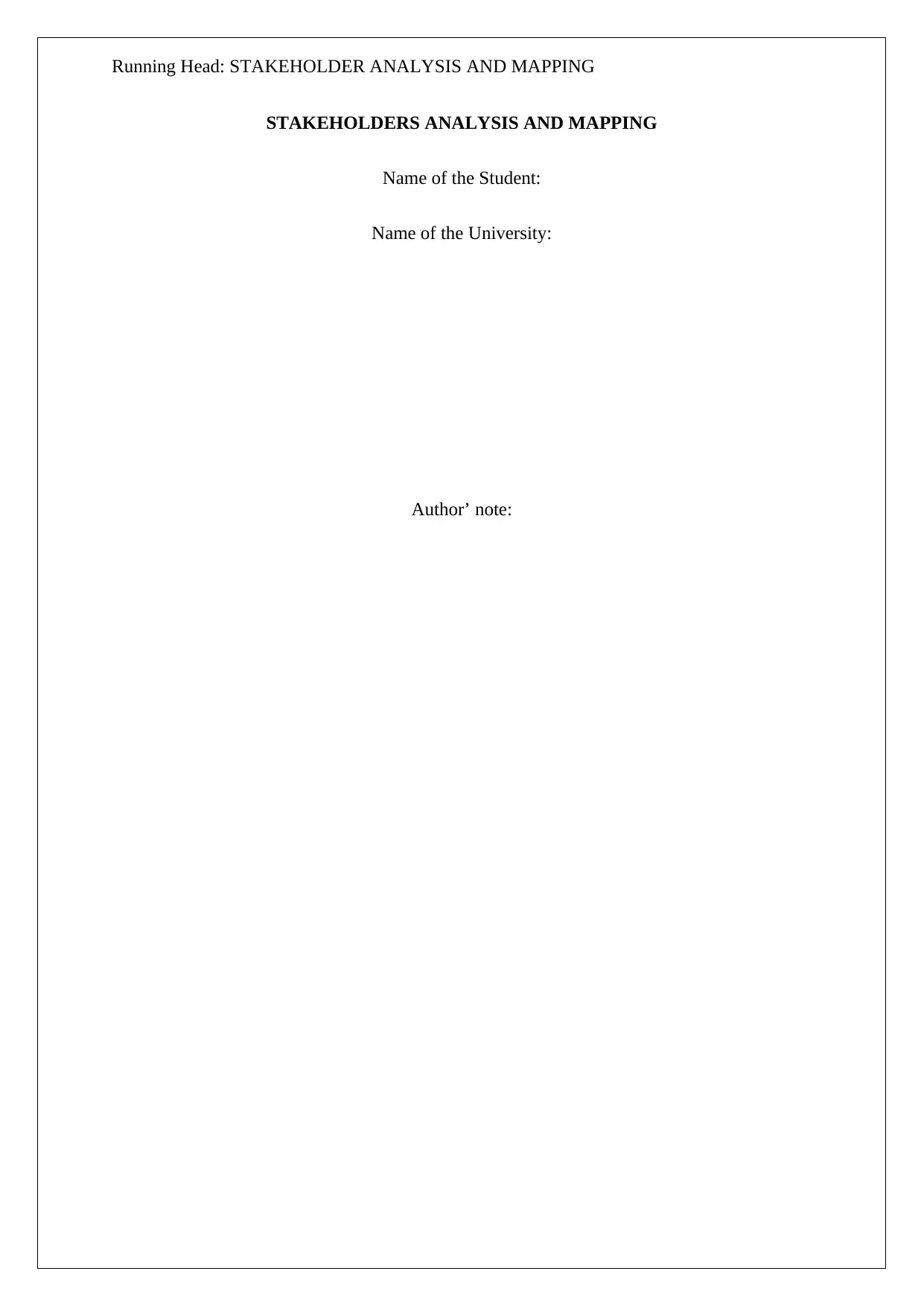
Running Head: STAKEHOLDER ANALYSIS AND MAPPING
STAKEHOLDERS ANALYSIS AND MAPPING
Name of the Student:
Name of the University:
Author’ note:
STAKEHOLDERS ANALYSIS AND MAPPING
Name of the Student:
Name of the University:
Author’ note:
Paraphrase This Document
Need a fresh take? Get an instant paraphrase of this document with our AI Paraphraser
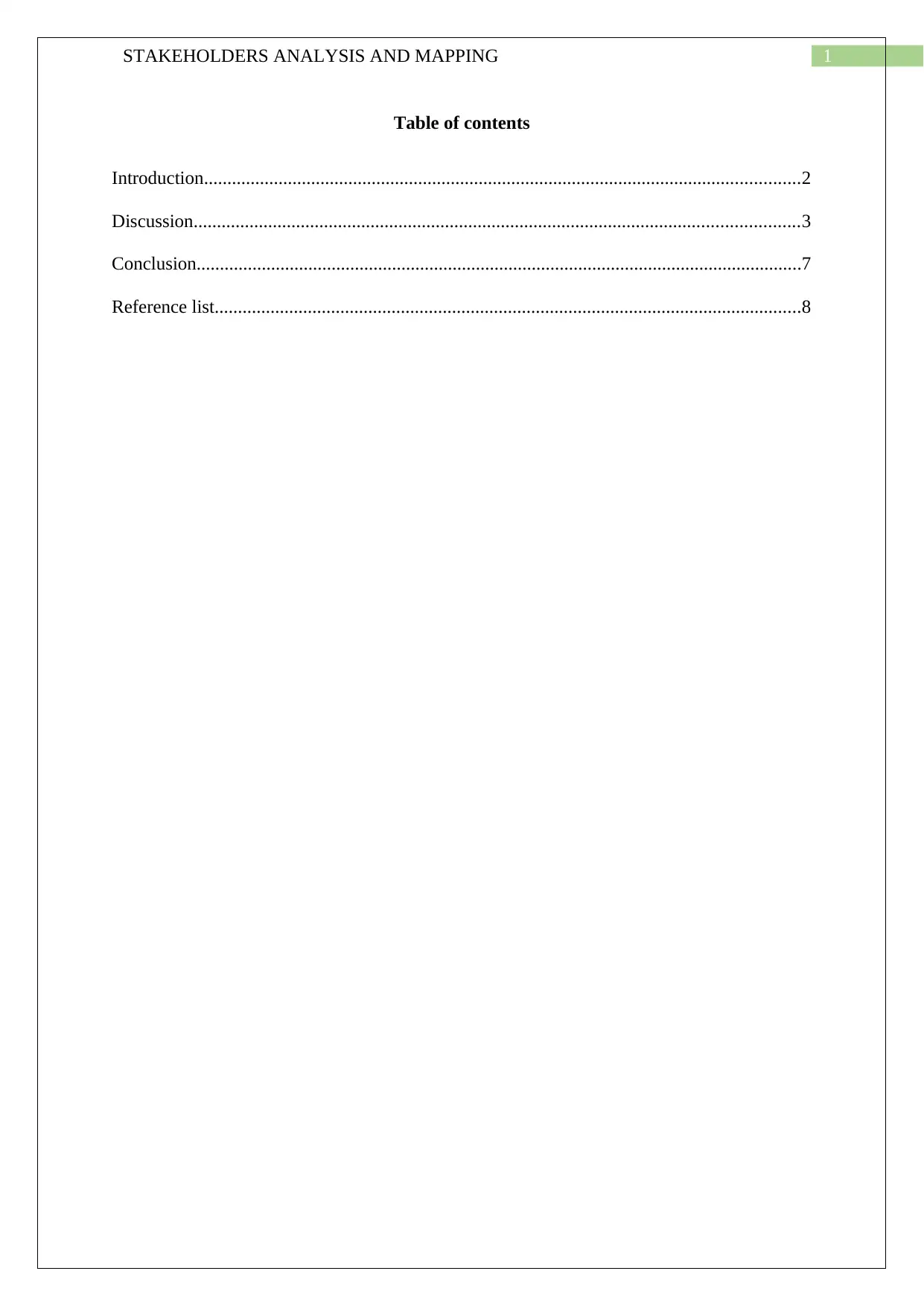
1STAKEHOLDERS ANALYSIS AND MAPPING
Table of contents
Introduction................................................................................................................................2
Discussion..................................................................................................................................3
Conclusion..................................................................................................................................7
Reference list..............................................................................................................................8
Table of contents
Introduction................................................................................................................................2
Discussion..................................................................................................................................3
Conclusion..................................................................................................................................7
Reference list..............................................................................................................................8
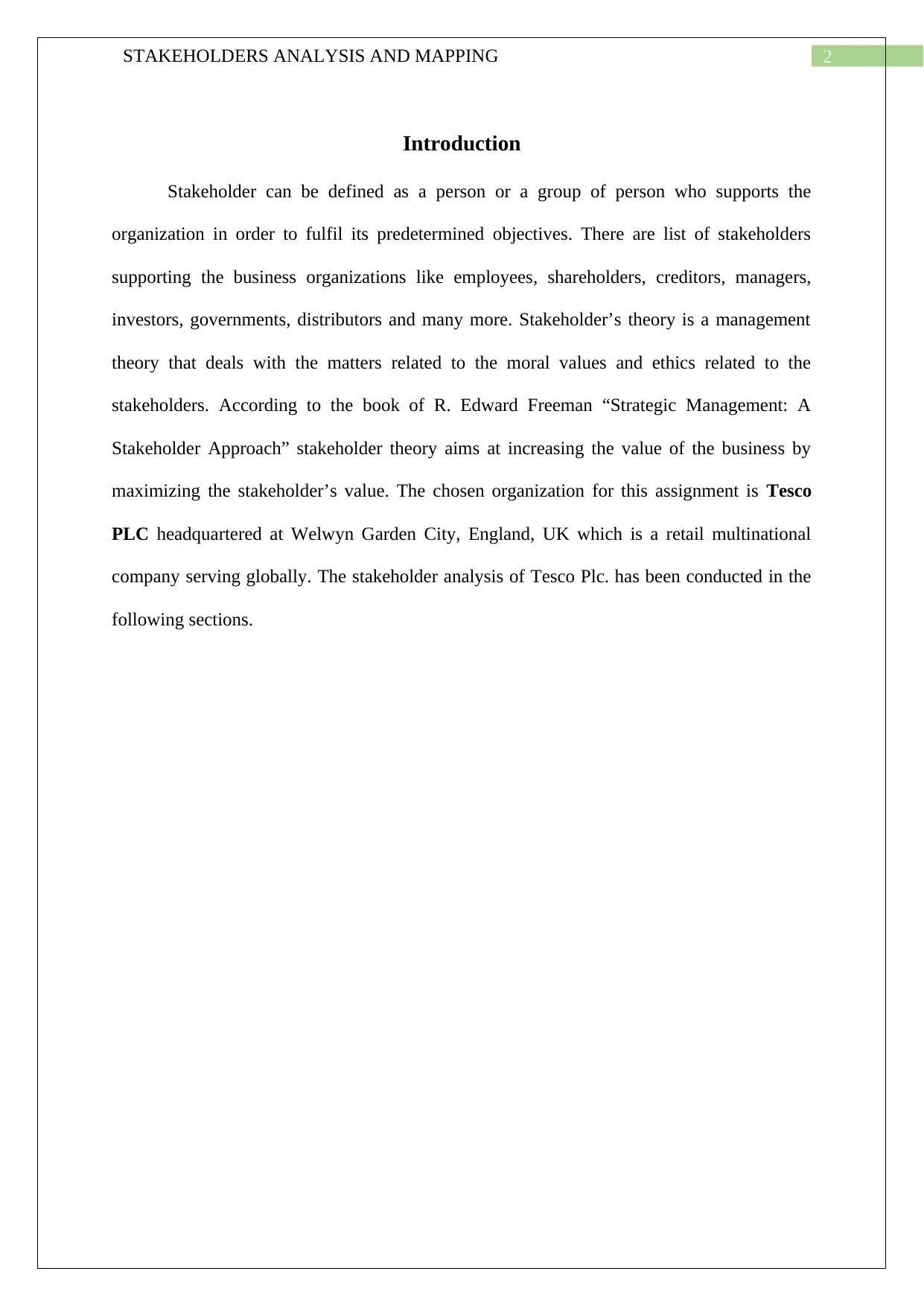
2STAKEHOLDERS ANALYSIS AND MAPPING
Introduction
Stakeholder can be defined as a person or a group of person who supports the
organization in order to fulfil its predetermined objectives. There are list of stakeholders
supporting the business organizations like employees, shareholders, creditors, managers,
investors, governments, distributors and many more. Stakeholder’s theory is a management
theory that deals with the matters related to the moral values and ethics related to the
stakeholders. According to the book of R. Edward Freeman “Strategic Management: A
Stakeholder Approach” stakeholder theory aims at increasing the value of the business by
maximizing the stakeholder’s value. The chosen organization for this assignment is Tesco
PLC headquartered at Welwyn Garden City, England, UK which is a retail multinational
company serving globally. The stakeholder analysis of Tesco Plc. has been conducted in the
following sections.
Introduction
Stakeholder can be defined as a person or a group of person who supports the
organization in order to fulfil its predetermined objectives. There are list of stakeholders
supporting the business organizations like employees, shareholders, creditors, managers,
investors, governments, distributors and many more. Stakeholder’s theory is a management
theory that deals with the matters related to the moral values and ethics related to the
stakeholders. According to the book of R. Edward Freeman “Strategic Management: A
Stakeholder Approach” stakeholder theory aims at increasing the value of the business by
maximizing the stakeholder’s value. The chosen organization for this assignment is Tesco
PLC headquartered at Welwyn Garden City, England, UK which is a retail multinational
company serving globally. The stakeholder analysis of Tesco Plc. has been conducted in the
following sections.
⊘ This is a preview!⊘
Do you want full access?
Subscribe today to unlock all pages.

Trusted by 1+ million students worldwide
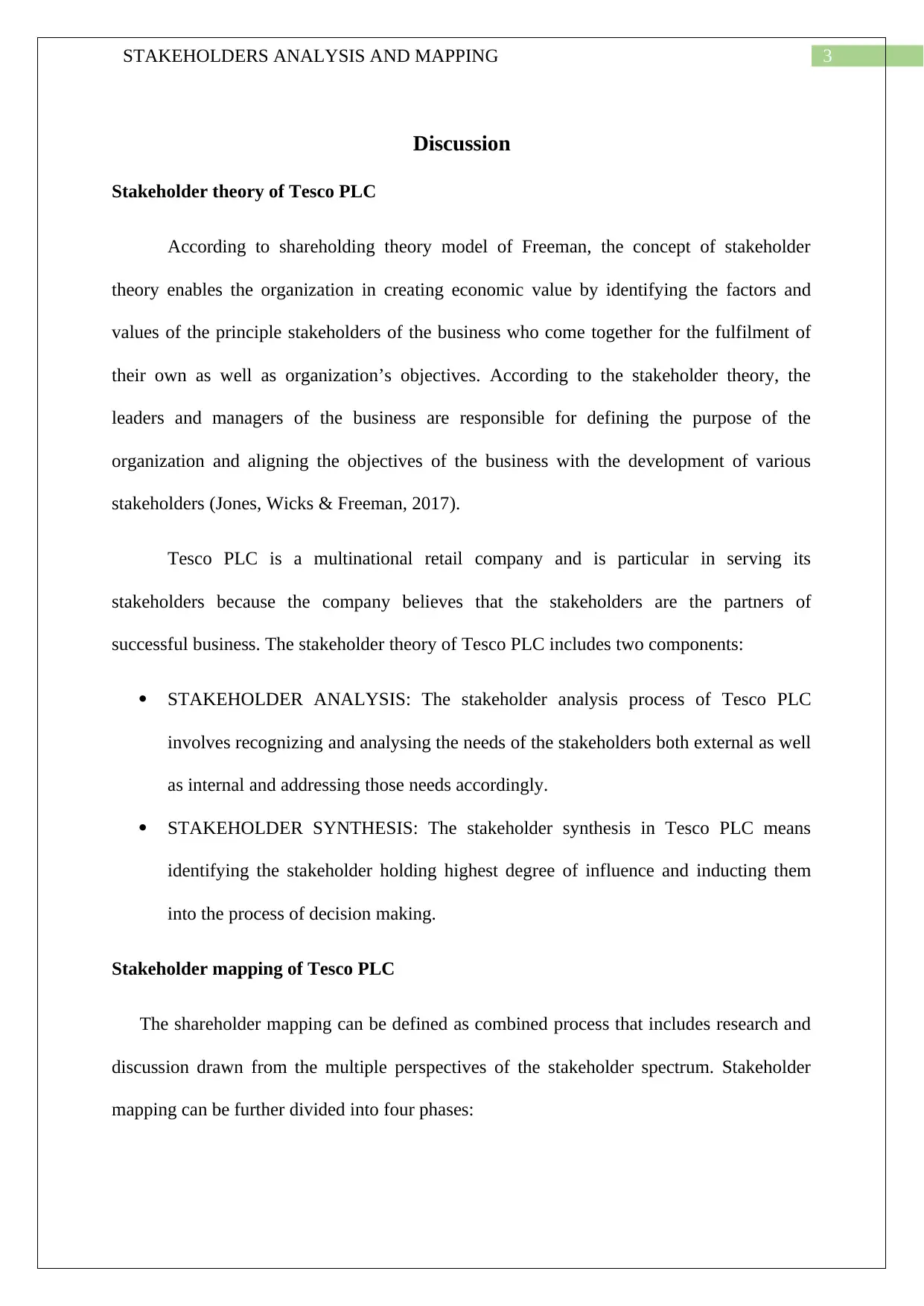
3STAKEHOLDERS ANALYSIS AND MAPPING
Discussion
Stakeholder theory of Tesco PLC
According to shareholding theory model of Freeman, the concept of stakeholder
theory enables the organization in creating economic value by identifying the factors and
values of the principle stakeholders of the business who come together for the fulfilment of
their own as well as organization’s objectives. According to the stakeholder theory, the
leaders and managers of the business are responsible for defining the purpose of the
organization and aligning the objectives of the business with the development of various
stakeholders (Jones, Wicks & Freeman, 2017).
Tesco PLC is a multinational retail company and is particular in serving its
stakeholders because the company believes that the stakeholders are the partners of
successful business. The stakeholder theory of Tesco PLC includes two components:
STAKEHOLDER ANALYSIS: The stakeholder analysis process of Tesco PLC
involves recognizing and analysing the needs of the stakeholders both external as well
as internal and addressing those needs accordingly.
STAKEHOLDER SYNTHESIS: The stakeholder synthesis in Tesco PLC means
identifying the stakeholder holding highest degree of influence and inducting them
into the process of decision making.
Stakeholder mapping of Tesco PLC
The shareholder mapping can be defined as combined process that includes research and
discussion drawn from the multiple perspectives of the stakeholder spectrum. Stakeholder
mapping can be further divided into four phases:
Discussion
Stakeholder theory of Tesco PLC
According to shareholding theory model of Freeman, the concept of stakeholder
theory enables the organization in creating economic value by identifying the factors and
values of the principle stakeholders of the business who come together for the fulfilment of
their own as well as organization’s objectives. According to the stakeholder theory, the
leaders and managers of the business are responsible for defining the purpose of the
organization and aligning the objectives of the business with the development of various
stakeholders (Jones, Wicks & Freeman, 2017).
Tesco PLC is a multinational retail company and is particular in serving its
stakeholders because the company believes that the stakeholders are the partners of
successful business. The stakeholder theory of Tesco PLC includes two components:
STAKEHOLDER ANALYSIS: The stakeholder analysis process of Tesco PLC
involves recognizing and analysing the needs of the stakeholders both external as well
as internal and addressing those needs accordingly.
STAKEHOLDER SYNTHESIS: The stakeholder synthesis in Tesco PLC means
identifying the stakeholder holding highest degree of influence and inducting them
into the process of decision making.
Stakeholder mapping of Tesco PLC
The shareholder mapping can be defined as combined process that includes research and
discussion drawn from the multiple perspectives of the stakeholder spectrum. Stakeholder
mapping can be further divided into four phases:
Paraphrase This Document
Need a fresh take? Get an instant paraphrase of this document with our AI Paraphraser
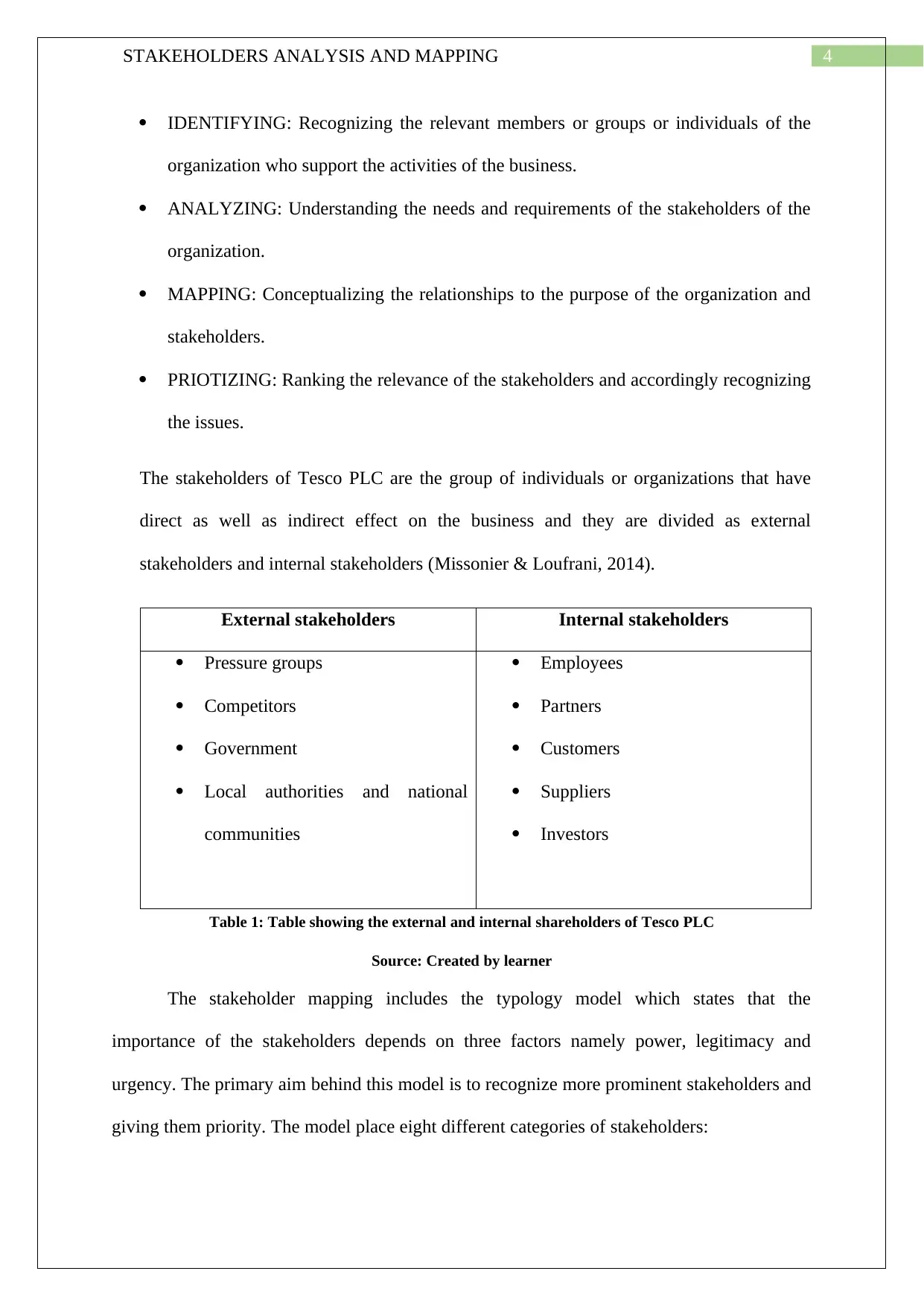
4STAKEHOLDERS ANALYSIS AND MAPPING
IDENTIFYING: Recognizing the relevant members or groups or individuals of the
organization who support the activities of the business.
ANALYZING: Understanding the needs and requirements of the stakeholders of the
organization.
MAPPING: Conceptualizing the relationships to the purpose of the organization and
stakeholders.
PRIOTIZING: Ranking the relevance of the stakeholders and accordingly recognizing
the issues.
The stakeholders of Tesco PLC are the group of individuals or organizations that have
direct as well as indirect effect on the business and they are divided as external
stakeholders and internal stakeholders (Missonier & Loufrani, 2014).
External stakeholders Internal stakeholders
Pressure groups
Competitors
Government
Local authorities and national
communities
Employees
Partners
Customers
Suppliers
Investors
Table 1: Table showing the external and internal shareholders of Tesco PLC
Source: Created by learner
The stakeholder mapping includes the typology model which states that the
importance of the stakeholders depends on three factors namely power, legitimacy and
urgency. The primary aim behind this model is to recognize more prominent stakeholders and
giving them priority. The model place eight different categories of stakeholders:
IDENTIFYING: Recognizing the relevant members or groups or individuals of the
organization who support the activities of the business.
ANALYZING: Understanding the needs and requirements of the stakeholders of the
organization.
MAPPING: Conceptualizing the relationships to the purpose of the organization and
stakeholders.
PRIOTIZING: Ranking the relevance of the stakeholders and accordingly recognizing
the issues.
The stakeholders of Tesco PLC are the group of individuals or organizations that have
direct as well as indirect effect on the business and they are divided as external
stakeholders and internal stakeholders (Missonier & Loufrani, 2014).
External stakeholders Internal stakeholders
Pressure groups
Competitors
Government
Local authorities and national
communities
Employees
Partners
Customers
Suppliers
Investors
Table 1: Table showing the external and internal shareholders of Tesco PLC
Source: Created by learner
The stakeholder mapping includes the typology model which states that the
importance of the stakeholders depends on three factors namely power, legitimacy and
urgency. The primary aim behind this model is to recognize more prominent stakeholders and
giving them priority. The model place eight different categories of stakeholders:
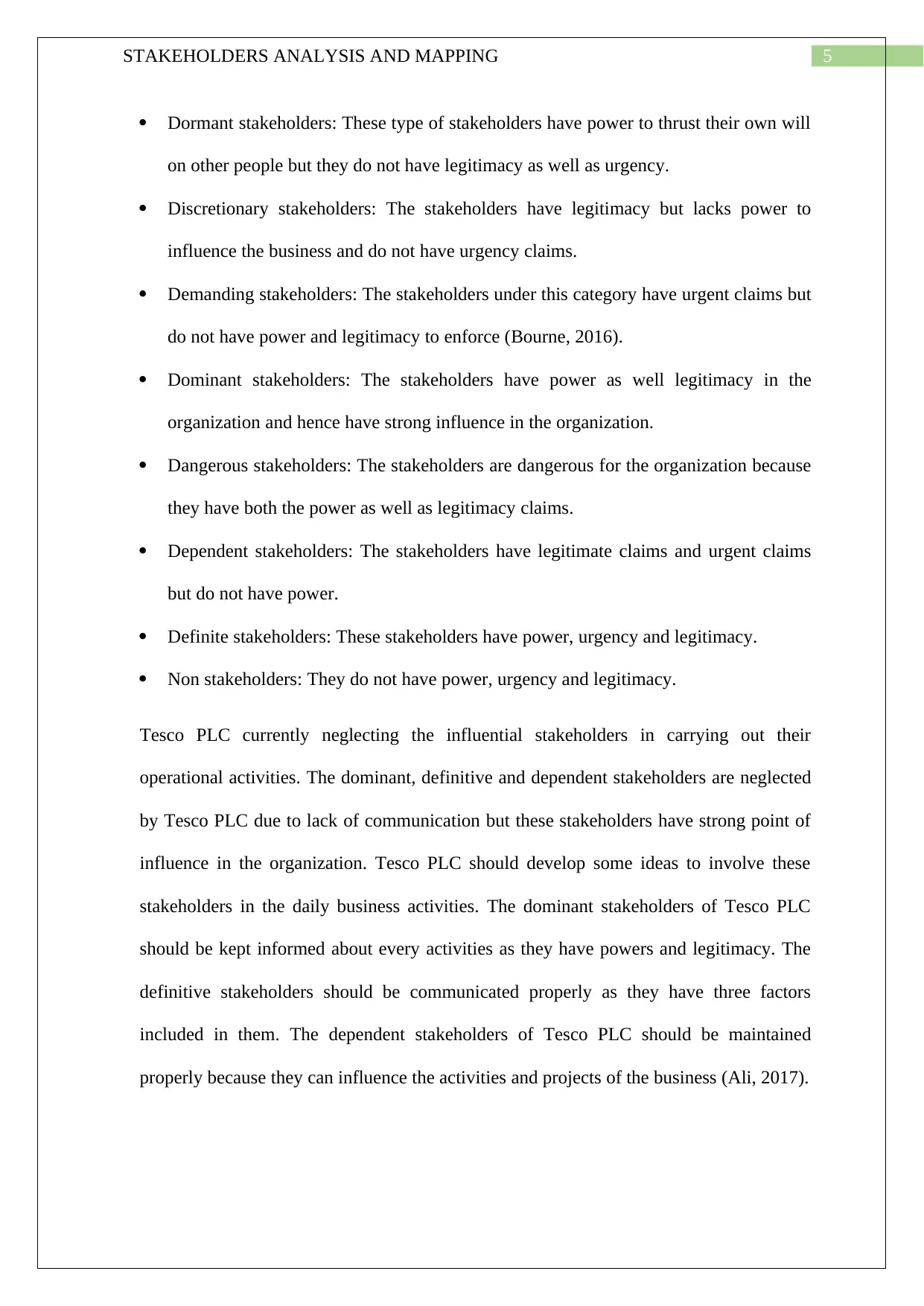
5STAKEHOLDERS ANALYSIS AND MAPPING
Dormant stakeholders: These type of stakeholders have power to thrust their own will
on other people but they do not have legitimacy as well as urgency.
Discretionary stakeholders: The stakeholders have legitimacy but lacks power to
influence the business and do not have urgency claims.
Demanding stakeholders: The stakeholders under this category have urgent claims but
do not have power and legitimacy to enforce (Bourne, 2016).
Dominant stakeholders: The stakeholders have power as well legitimacy in the
organization and hence have strong influence in the organization.
Dangerous stakeholders: The stakeholders are dangerous for the organization because
they have both the power as well as legitimacy claims.
Dependent stakeholders: The stakeholders have legitimate claims and urgent claims
but do not have power.
Definite stakeholders: These stakeholders have power, urgency and legitimacy.
Non stakeholders: They do not have power, urgency and legitimacy.
Tesco PLC currently neglecting the influential stakeholders in carrying out their
operational activities. The dominant, definitive and dependent stakeholders are neglected
by Tesco PLC due to lack of communication but these stakeholders have strong point of
influence in the organization. Tesco PLC should develop some ideas to involve these
stakeholders in the daily business activities. The dominant stakeholders of Tesco PLC
should be kept informed about every activities as they have powers and legitimacy. The
definitive stakeholders should be communicated properly as they have three factors
included in them. The dependent stakeholders of Tesco PLC should be maintained
properly because they can influence the activities and projects of the business (Ali, 2017).
Dormant stakeholders: These type of stakeholders have power to thrust their own will
on other people but they do not have legitimacy as well as urgency.
Discretionary stakeholders: The stakeholders have legitimacy but lacks power to
influence the business and do not have urgency claims.
Demanding stakeholders: The stakeholders under this category have urgent claims but
do not have power and legitimacy to enforce (Bourne, 2016).
Dominant stakeholders: The stakeholders have power as well legitimacy in the
organization and hence have strong influence in the organization.
Dangerous stakeholders: The stakeholders are dangerous for the organization because
they have both the power as well as legitimacy claims.
Dependent stakeholders: The stakeholders have legitimate claims and urgent claims
but do not have power.
Definite stakeholders: These stakeholders have power, urgency and legitimacy.
Non stakeholders: They do not have power, urgency and legitimacy.
Tesco PLC currently neglecting the influential stakeholders in carrying out their
operational activities. The dominant, definitive and dependent stakeholders are neglected
by Tesco PLC due to lack of communication but these stakeholders have strong point of
influence in the organization. Tesco PLC should develop some ideas to involve these
stakeholders in the daily business activities. The dominant stakeholders of Tesco PLC
should be kept informed about every activities as they have powers and legitimacy. The
definitive stakeholders should be communicated properly as they have three factors
included in them. The dependent stakeholders of Tesco PLC should be maintained
properly because they can influence the activities and projects of the business (Ali, 2017).
⊘ This is a preview!⊘
Do you want full access?
Subscribe today to unlock all pages.

Trusted by 1+ million students worldwide
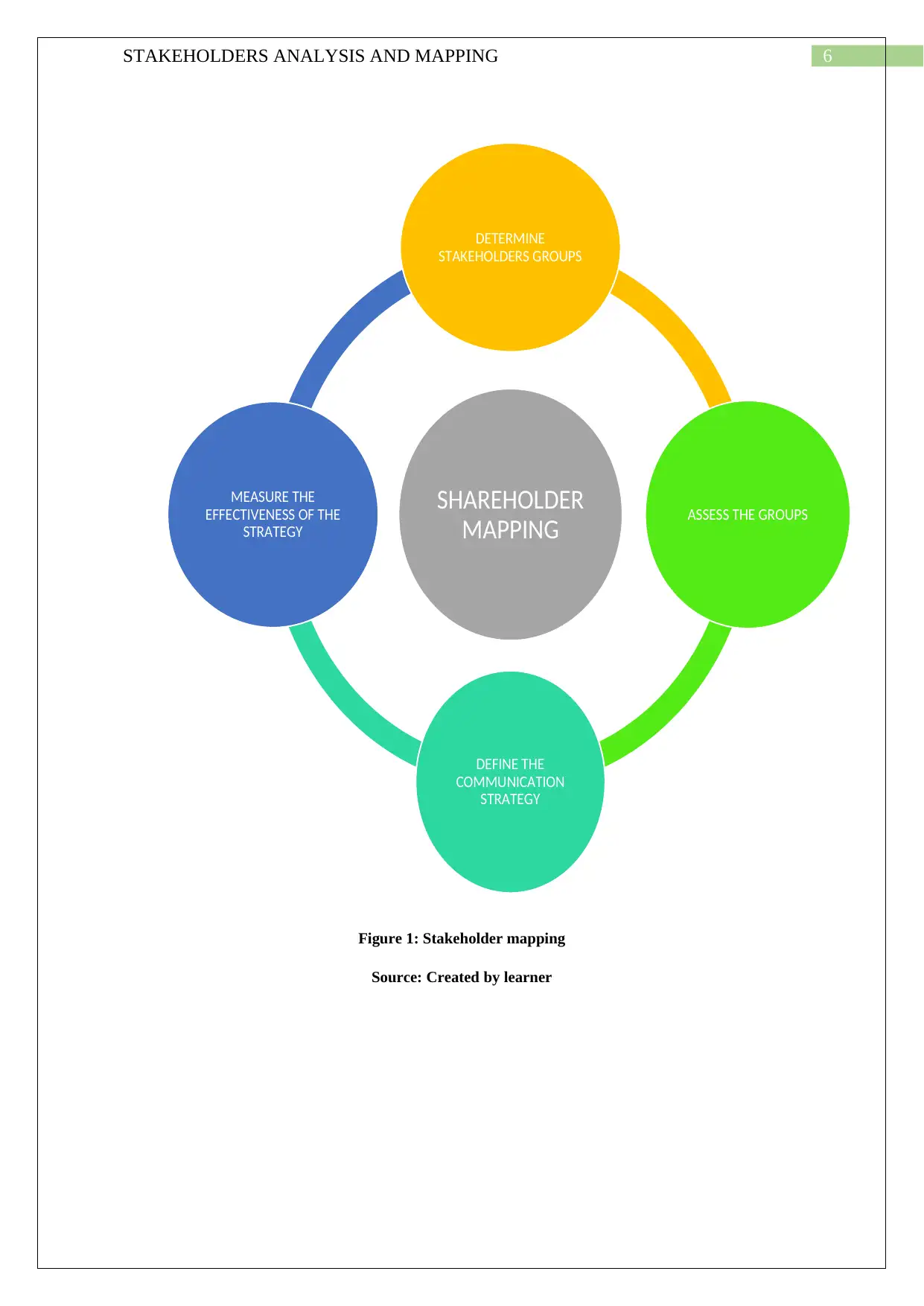
6STAKEHOLDERS ANALYSIS AND MAPPING
Figure 1: Stakeholder mapping
Source: Created by learner
SHAREHOLDER
MAPPING
DETERMINE
STAKEHOLDERS GROUPS
ASSESS THE GROUPS
DEFINE THE
COMMUNICATION
STRATEGY
MEASURE THE
EFFECTIVENESS OF THE
STRATEGY
Figure 1: Stakeholder mapping
Source: Created by learner
SHAREHOLDER
MAPPING
DETERMINE
STAKEHOLDERS GROUPS
ASSESS THE GROUPS
DEFINE THE
COMMUNICATION
STRATEGY
MEASURE THE
EFFECTIVENESS OF THE
STRATEGY
Paraphrase This Document
Need a fresh take? Get an instant paraphrase of this document with our AI Paraphraser
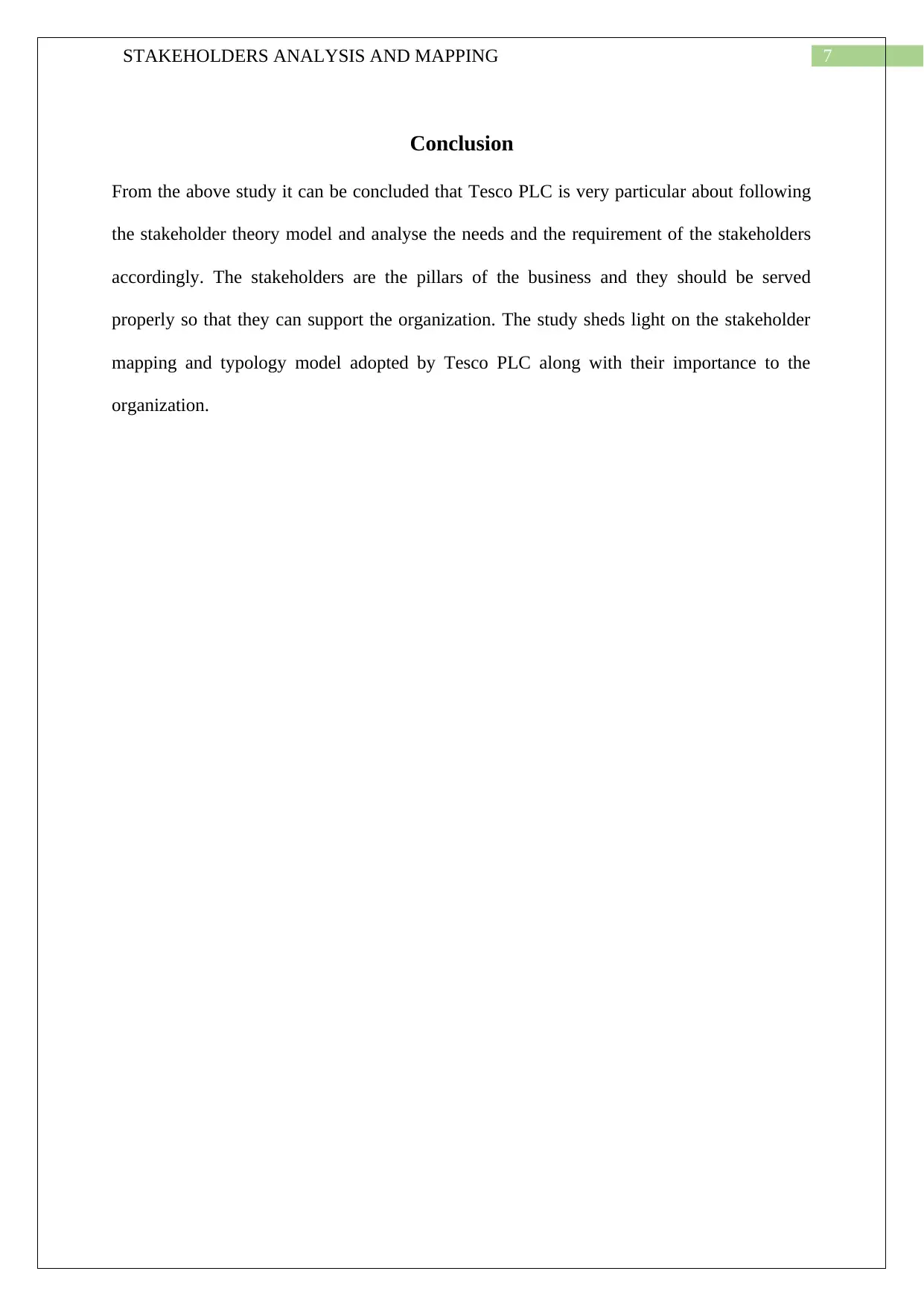
7STAKEHOLDERS ANALYSIS AND MAPPING
Conclusion
From the above study it can be concluded that Tesco PLC is very particular about following
the stakeholder theory model and analyse the needs and the requirement of the stakeholders
accordingly. The stakeholders are the pillars of the business and they should be served
properly so that they can support the organization. The study sheds light on the stakeholder
mapping and typology model adopted by Tesco PLC along with their importance to the
organization.
Conclusion
From the above study it can be concluded that Tesco PLC is very particular about following
the stakeholder theory model and analyse the needs and the requirement of the stakeholders
accordingly. The stakeholders are the pillars of the business and they should be served
properly so that they can support the organization. The study sheds light on the stakeholder
mapping and typology model adopted by Tesco PLC along with their importance to the
organization.
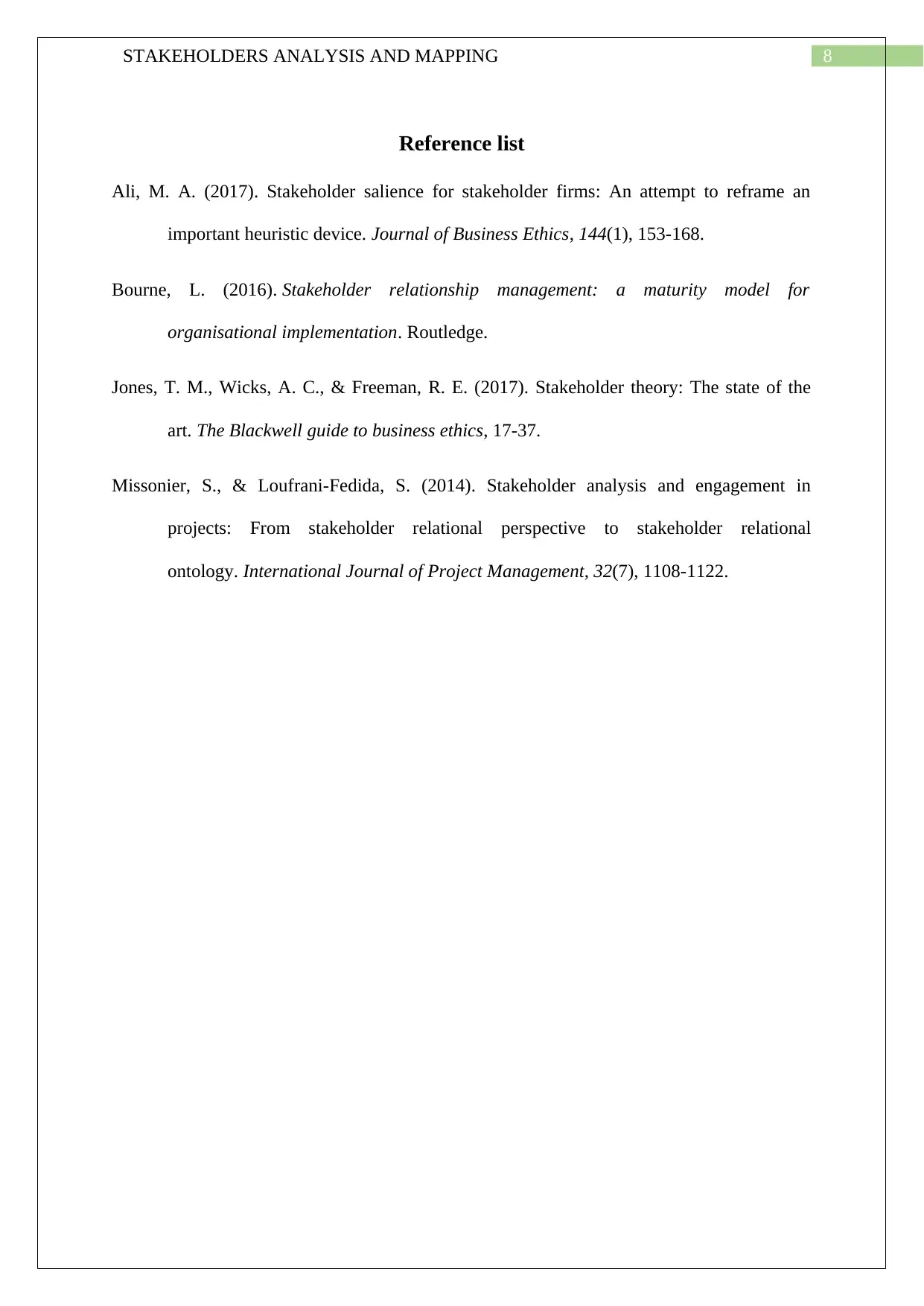
8STAKEHOLDERS ANALYSIS AND MAPPING
Reference list
Ali, M. A. (2017). Stakeholder salience for stakeholder firms: An attempt to reframe an
important heuristic device. Journal of Business Ethics, 144(1), 153-168.
Bourne, L. (2016). Stakeholder relationship management: a maturity model for
organisational implementation. Routledge.
Jones, T. M., Wicks, A. C., & Freeman, R. E. (2017). Stakeholder theory: The state of the
art. The Blackwell guide to business ethics, 17-37.
Missonier, S., & Loufrani-Fedida, S. (2014). Stakeholder analysis and engagement in
projects: From stakeholder relational perspective to stakeholder relational
ontology. International Journal of Project Management, 32(7), 1108-1122.
Reference list
Ali, M. A. (2017). Stakeholder salience for stakeholder firms: An attempt to reframe an
important heuristic device. Journal of Business Ethics, 144(1), 153-168.
Bourne, L. (2016). Stakeholder relationship management: a maturity model for
organisational implementation. Routledge.
Jones, T. M., Wicks, A. C., & Freeman, R. E. (2017). Stakeholder theory: The state of the
art. The Blackwell guide to business ethics, 17-37.
Missonier, S., & Loufrani-Fedida, S. (2014). Stakeholder analysis and engagement in
projects: From stakeholder relational perspective to stakeholder relational
ontology. International Journal of Project Management, 32(7), 1108-1122.
⊘ This is a preview!⊘
Do you want full access?
Subscribe today to unlock all pages.

Trusted by 1+ million students worldwide
1 out of 9
Related Documents
Your All-in-One AI-Powered Toolkit for Academic Success.
+13062052269
info@desklib.com
Available 24*7 on WhatsApp / Email
![[object Object]](/_next/static/media/star-bottom.7253800d.svg)
Unlock your academic potential
Copyright © 2020–2025 A2Z Services. All Rights Reserved. Developed and managed by ZUCOL.




